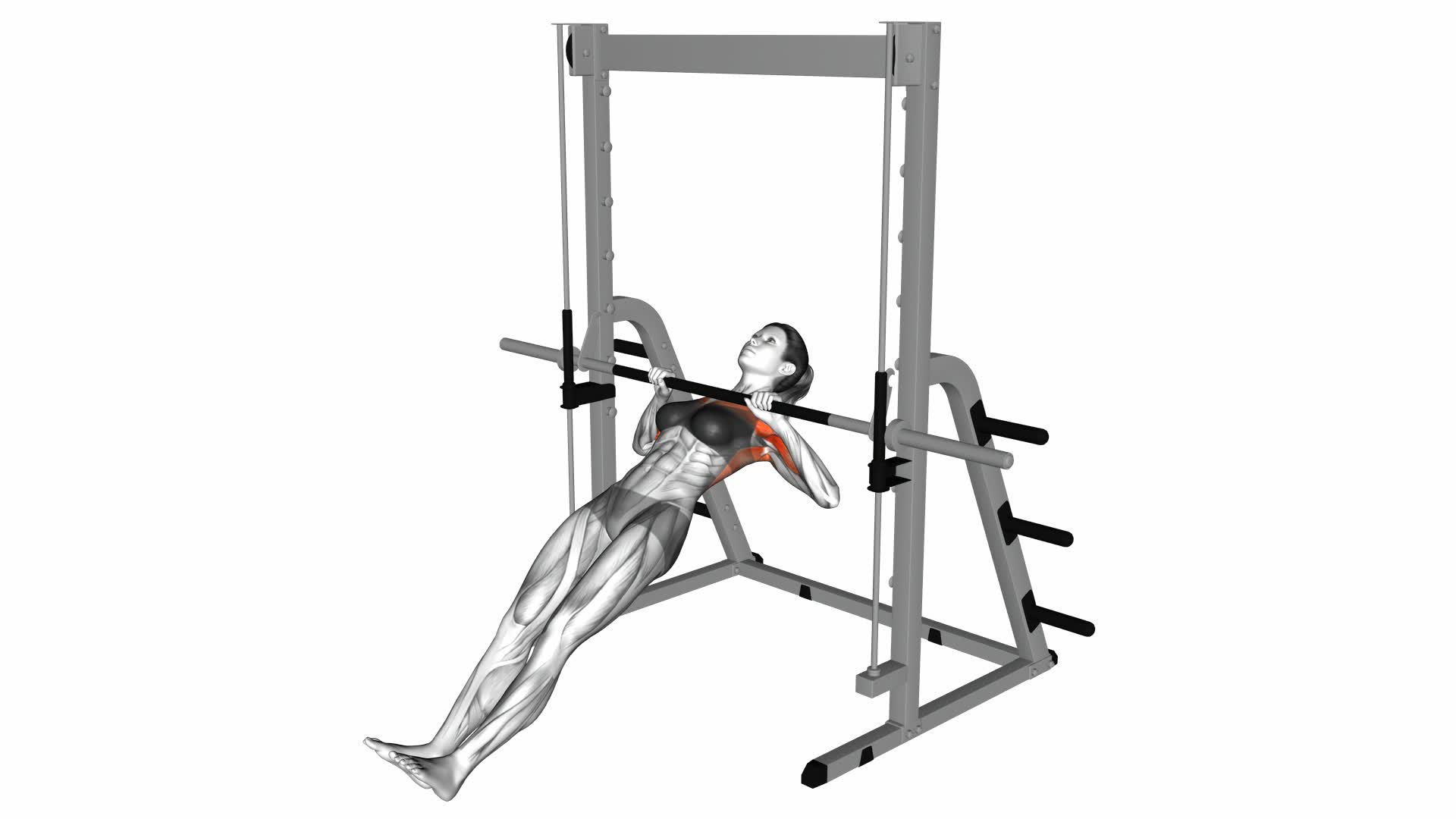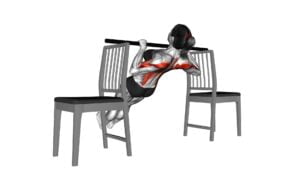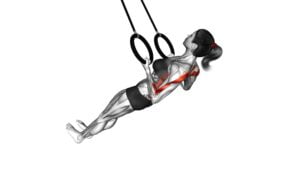Inverted Row (female) – Video Exercise Guide & Tips

Are you looking to strengthen your back, arms, and core? Look no further than the Inverted Row!
Watch This Exercise Video
This exercise guide and video will show you how to perform this effective move with proper form and technique. Whether you're a beginner or more advanced, we'll also provide modifications and progressions to challenge you at your own level.
Say goodbye to common mistakes and hello to maximizing your results. Get ready to take your fitness journey to new heights!
Key Takeaways
- The inverted row is a great exercise for developing strong and toned back muscles in females.
- Proper form and technique, such as maintaining shoulder positioning and avoiding common form mistakes, is important for effectively targeting the back muscles and preventing strain on the neck.
- Modifications and progressions, such as elevating the feet or using resistance bands, can be used to increase the difficulty of the exercise and continue challenging the body.
- Rest and recovery are crucial for muscle repair and growth, and should be prioritized to maximize the benefits of the inverted row exercise.
Benefits of the Inverted Row
One major benefit of the inverted row is that it helps you develop strong and toned back muscles. The inverted row is a versatile exercise that targets your upper body strength, specifically your back muscles. By performing inverted row variations, such as using different grips or elevating your feet, you can target different areas of your back and increase the intensity of the exercise. This exercise engages multiple muscles in your upper body, including your lats, rhomboids, and biceps, helping you build strength and muscle definition.
In addition to developing a strong and toned back, the inverted row also improves your posture. Many people spend hours sitting at a desk or hunched over electronic devices, which can lead to rounded shoulders and a forward head posture. By strengthening your back muscles through the inverted row, you can counteract these imbalances and promote better alignment.
To perform the inverted row, you don't need any fancy equipment. All you need is a sturdy bar or suspension trainer that can support your body weight. This makes it a convenient exercise that you can do at home or at the gym. So, whether you're a beginner or an advanced fitness enthusiast, the inverted row is a highly effective exercise for developing upper body strength and improving your overall posture.
Equipment Needed for the Inverted Row
To perform the inverted row effectively, there are a few essential pieces of equipment that you'll need. These include a sturdy bar or suspension trainer that can support your body weight, as well as a secure anchor point to attach it to.
However, if you don't have access to these traditional options, there are alternative equipment choices available that can still provide a challenging and effective workout. Investing in the right equipment won't only ensure your safety and stability during the exercise, but it will also allow you to fully reap the benefits of the inverted row.
Essential Equipment for Row
You will need three pieces of equipment for the Inverted Row exercise.
First, you'll need a sturdy horizontal bar or a suspension trainer that can support your body weight. It's important to select a bar or trainer that's stable and secure, as this will provide a safe and effective workout.
Additionally, you'll need a pair of comfortable and supportive grip handles. These handles should allow you to maintain a firm grip throughout the exercise, preventing any slips or accidents.
Lastly, using a mat or a soft surface underneath the bar or trainer can provide extra cushioning and support for your back during the exercise.
Alternatives to Traditional Equipment
For the Inverted Row exercise, there are alternative options to traditional equipment that can be used. If you don't have access to a gym or specific equipment, don't worry! There are bodyweight exercises that you can do at home to get the same benefits.
One option is to use a sturdy table or countertop. Lie underneath it and grab the edge with your hands, keeping your body straight. Pull yourself up towards the edge of the table, engaging your back muscles.
Another option is to use resistance bands. Attach them securely to a door or pole, and hold onto the bands while performing the rowing motion.
These alternatives allow you to still perform the Inverted Row and get a great workout in the comfort of your own home. Don't let the lack of equipment hold you back from achieving your fitness goals!
Benefits of Proper Equipment
One essential piece of equipment needed for the Inverted Row exercise is a sturdy bar or set of parallel bars. Having the proper equipment is crucial to ensuring that you can perform the exercise safely and effectively.
Here are some benefits of using the right equipment for the Inverted Row:
- Stability: A sturdy bar or set of parallel bars provides stability during the exercise, allowing you to focus on proper technique and form.
- Grip: The equipment allows for a secure grip, reducing the risk of slipping or losing control while performing the exercise.
By using the proper equipment, you can maximize the benefits of the Inverted Row and achieve better results.
Now that you understand the importance of having the right equipment, let's move on to learning about the proper form and technique for the inverted row.
Proper Form and Technique for the Inverted Row
To perform the inverted row with proper form and technique, it's crucial to pay attention to your shoulder positioning. Keep your shoulders down and back, engaging your back muscles throughout the exercise. This will help prevent strain on the neck and ensure that you're effectively targeting your back muscles.
Avoid common form mistakes such as using momentum or arching your back, as these can compromise the effectiveness of the exercise and increase the risk of injury.
Shoulder Positioning Importance
To ensure proper form and technique during the Inverted Row, it's essential that you focus on the positioning of your shoulders. The importance of shoulder stability can't be overstated, as it not only helps prevent injury but also ensures maximum muscle engagement and effectiveness of the exercise.
Correct shoulder alignment is crucial for maintaining proper posture and distributing the load evenly throughout your upper body. Here are a few key points to keep in mind:
- Keep your shoulders pulled back and down throughout the movement to avoid rounding or hunching.
- Engage your shoulder blades by squeezing them together, creating a stable base for the exercise.
- Avoid shrugging your shoulders or allowing them to elevate toward your ears, as this can lead to strain and tension.
Engaging Back Muscles
To effectively engage your back muscles during the Inverted Row, focus on pulling your shoulder blades together and down. This movement is crucial for activating the muscles in your upper back, including the rhomboids, trapezius, and latissimus dorsi. By consciously squeezing your shoulder blades together and down, you create tension in the targeted muscles, allowing for a more effective back workout.
Engaging your back muscles properly during the Inverted Row is essential for maximizing strength and toning. It not only helps in building a strong and defined back but also improves your posture and overall upper body stability. By incorporating this technique into your inverted row routine, you can ensure that you're targeting the right muscles and getting the most out of your workout.
Common Form Mistakes
In the article about the Inverted Row (female) – Video Exercise Guide & Tips {229912}, we'll now address common form mistakes to ensure proper form and technique for the Inverted Row.
It's crucial to maintain correct shoulder alignment during this exercise. Improper alignment can lead to strain and potential injury. Make sure your shoulders are pulled back and down, away from your ears, throughout the movement.
Additionally, your hand grip is essential for proper execution. Avoid gripping the bar too tightly, as this can cause unnecessary tension in your forearms and wrists. Instead, aim for a firm but relaxed grip, allowing your back muscles to do the work.
Modifications and Progressions for the Inverted Row
Try incorporating these modifications and progressions into your inverted row routine to challenge yourself and make continuous improvements.
Modifying the inverted row can help you target different muscle groups and increase the difficulty of the exercise. One modification you can try is elevating your feet on a bench or step. This will increase the angle of your body and require more strength from your upper back and arms.
Another modification is using a resistance band or TRX straps to assist you in completing the movement. This is especially helpful if you're new to the exercise or working towards building strength.
To progress the inverted row, you can start by increasing the number of repetitions or sets you perform. This will help build endurance and muscular strength. Once you feel comfortable with the exercise, you can also increase the difficulty by adding weight. You can hold a dumbbell or place a weighted plate on your chest to challenge yourself further.
By incorporating these modifications and progressions, you'll be able to continually challenge your body and see improvements in your strength and muscle definition.
Now, let's move on to the next section and learn about common mistakes to avoid when performing the inverted row.
Common Mistakes to Avoid When Performing the Inverted Row
To avoid common mistakes when performing the inverted row, focus on maintaining proper form and engaging the correct muscle groups throughout the exercise. This won't only help you get the most out of the exercise but also prevent any potential injuries. Here are some common mistakes to avoid and tips to ensure you perform the inverted row correctly:
- Avoiding injury:
- Ensure your body remains in a straight line throughout the movement, from head to heels. Avoid arching your back or sagging your hips.
- Keep your core engaged and your glutes squeezed to maintain stability and prevent any strain on your lower back.
- Proper grip technique:
- Use an overhand grip with your palms facing away from you and your hands slightly wider than shoulder-width apart. This grip will engage your back muscles effectively.
- Keep your shoulders down and back, away from your ears, to maintain proper scapular position and prevent any unnecessary strain on your shoulders.
Tips for Maximizing Your Results With the Inverted Row
To maximize your results with the inverted row, focus on increasing the number of repetitions you perform. By doing so, you'll be able to challenge your muscles and stimulate growth, ultimately maximizing gains and improving performance.
One tip for increasing the number of repetitions is to start with a weight that allows you to perform 8-12 reps with good form. As you become stronger, gradually increase the weight to continue challenging your muscles.
Another way to maximize your results is to incorporate variations of the inverted row, such as using different grip widths or elevating your feet on a bench. This will target different muscle groups and prevent your body from adapting to the same exercise.
Additionally, make sure to maintain proper form throughout the exercise. Keep your core engaged, shoulders pulled back, and elbows tucked in close to your sides. This will ensure that you're effectively targeting your back muscles and minimizing the risk of injury.
Lastly, don't forget to rest and recover. Your muscles need time to repair and grow stronger. Aim for at least 48 hours of rest between inverted row sessions to allow for optimal recovery.
Frequently Asked Questions
How Many Sets and Reps Should I Do When Performing the Inverted Row?
When performing the inverted row, it's important to consider how many sets and reps to do.
The inverted row is a great exercise that targets your back muscles and improves your upper body strength.
To get the most out of this exercise, aim for 3-4 sets of 8-12 reps. This will help you build strength and endurance.
Can I Perform the Inverted Row if I Have a Shoulder Injury?
If you have a shoulder injury, it's important to modify your workout routine to avoid further damage.
When it comes to the inverted row, there are alternative exercises that can be done to protect your shoulder.
It's crucial to consult with a healthcare professional or a qualified trainer to get guidance on which exercises are suitable for your specific injury.
Don't let a shoulder injury hold you back from staying active and finding alternative ways to strengthen your upper body.
Is It Necessary to Warm up Before Doing the Inverted Row?
Before performing the inverted row, it's highly recommended that you warm up first. Warming up helps prepare your muscles and joints for the exercise, reducing the risk of injury. It also increases blood flow and flexibility, enhancing your performance.
If you're a beginner, there are modifications available to make the inverted row more manageable. By starting with a higher bar or using a resistance band, you can gradually build strength and progress to the full exercise.
How Long Should I Rest Between Sets When Doing the Inverted Row?
When it comes to rest periods during the inverted row, it's important to find a balance that works for you. Resting too long can make the exercise less challenging, while not resting enough can lead to fatigue and poor form.
As you progress, you can gradually decrease your rest periods to increase the intensity of the workout. Remember, the goal is to challenge yourself and continue to improve.
Can the Inverted Row Help Improve My Posture?
Improving your posture is one of the many benefits of the inverted row. By engaging your back, shoulders, and core muscles, this exercise helps strengthen and align your spine, leading to better posture.
To reap these benefits, it's important to maintain proper form. Avoid common mistakes like shrugging your shoulders or arching your back. Focus on squeezing your shoulder blades together and keeping your body in a straight line.
Embrace the inverted row and watch your posture improve!
Conclusion
In conclusion, the inverted row is a highly effective exercise for women that offers numerous benefits. By targeting the back muscles, it helps improve posture, strengthen the upper body, and enhance overall fitness.
With the proper equipment and technique, modifications can be made to suit individual fitness levels and progressions can be made to challenge oneself further. Avoiding common mistakes and following the tips provided will ensure optimal results.
Make the most of your workouts with the inverted row and achieve your fitness goals.

Author
Years ago, the spark of my life’s passion ignited in my mind the moment I stepped into the local gym for the first time. The inaugural bead of perspiration, the initial endeavor, the very first surge of endorphins, and a sense of pride that washed over me post-workout marked the beginning of my deep-seated interest in strength sports, fitness, and sports nutrition. This very curiosity blossomed rapidly into a profound fascination, propelling me to earn a Master’s degree in Physical Education from the Academy of Physical Education in Krakow, followed by a Sports Manager diploma from the Jagiellonian University. My journey of growth led me to gain more specialized qualifications, such as being a certified personal trainer with a focus on sports dietetics, a lifeguard, and an instructor for wellness and corrective gymnastics. Theoretical knowledge paired seamlessly with practical experience, reinforcing my belief that the transformation of individuals under my guidance was also a reflection of my personal growth. This belief holds true even today. Each day, I strive to push the boundaries and explore new realms. These realms gently elevate me to greater heights. The unique combination of passion for my field and the continuous quest for growth fuels my drive to break new ground.







